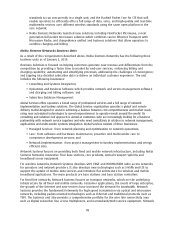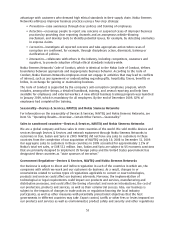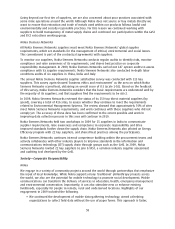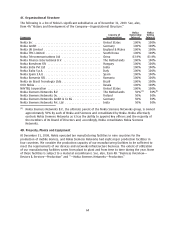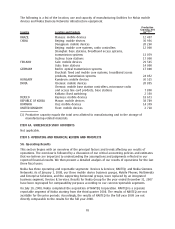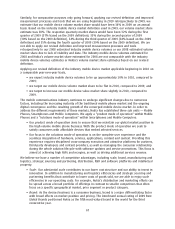Nokia 2009 Annual Report Download - page 59
Download and view the complete annual report
Please find page 59 of the 2009 Nokia annual report below. You can navigate through the pages in the report by either clicking on the pages listed below, or by using the keyword search tool below to find specific information within the annual report.Suppliers—Corporate Responsibility
Nokia
During 2009, we continued to work with suppliers to promote environmentally and socially
responsible behavior through our supplier requirements, assessments, development programs and
sourcing practices.
At December 31, 2009, 92% of our direct suppliers’ sites serving Nokia were certified to
Environmental Management System (EMS) ISO14001. These certified suppliers accounted for more than
98% of our hardware purchasing expenditure during the year.
We have further increased the visibility of our suppliers’ environmental performance and target
setting, concentrating on four key areas: energy consumption, carbon dioxide (equivalent) emissions,
water consumption and waste generation. Looking at the suppliers of commodities (representing
70% of our overall expenditure on hardware) which have the highest impact from a life cycle analysis
perspective, 93% have companylevel reduction targets for energy, carbon dioxide (equivalent), water
and waste in place and monitored. In 2010, we plan to extend this scope further as part of
continuous improvement.
Regarding the European Union Regulation on Registration, Evaluation, Authorisation and Restriction of
Chemicals (REACH), we have continued to work with all our direct suppliers to ensure that necessary
actions are in place to support regulatory compliance within the supply chain.
One expectation for suppliers is that they have a companylevel Code of Conduct in place. Codes of
conduct set out requirements in several areas, such as corruption, general business routines, health
and safety, human rights, working conditions, social rights and environmental standards. We surveyed
our suppliers’ Code of Conduct implementation and found that 92% met our requirements. Suppliers
not meeting our expectations have been requested to take corrective action.
To monitor supplier performance against our requirements and promote sustainability improvements,
Nokia conducts supplier selfassessments and onsite supplier assessments. In July 2009, we started
to use the ETASC (Electronics—Tool for Accountable Supply Chains) selfassessment questionnaire
(SAQ) to replace our own selfassessment tool for labor, health and safety, ethics and environmental
practices. ETASC, a joint effort of the Global eSustainability Initiative (GeSi) and the Electronic
Industry Citizenship Coalition (EICC), is a webbased information management system to help
companies collect, manage, and analyze social and environmental responsibility (SER) data provided
voluntarily by their suppliers. By the end of 2009, 14 Nokia suppliers had completed a total of 59
ETASC SAQs, of which 12 were corporatelevel SAQs covering overall company performance on
environmental and social criteria, and 47 were facilitylevel SAQs covering performance at production,
administrative and service unit level. The average corporate SAQ score was 89.5% and average facility
SAQ score was 87.4%. A higher percentage score indicates a lower risk that the supplier’s labor,
health and safety, ethics and environmental practices and processes are falling short of expectations.
Conversely, a lower percentage score indicates a higher risk that the supplier is falling short of
standards.
During 2009, we conducted 58% Nokia Supplier Requirements assessments and five indepth labor,
health and safety and environmental assessments. Indepth labor, health and safety and
environmental assessments are typically conducted by Nokia at those suppliers in locations or
industries with identified risk.
Nokia conducts an annual Supplier Satisfaction Survey. In 2009, the overall satisfaction survey result
was 79%, on a scale where 0% represents an unacceptable level and 100% represents an excellent
level. Overall satisfaction reflects how Nokia performs on areas such as planning and relationship
management and whether other business expectations force suppliers to compromise on their
environmental and ethical level of compliance. The overall satisfaction level of suppliers with respect
to Nokia’s approach to corporate responsibility was 91%.
57




